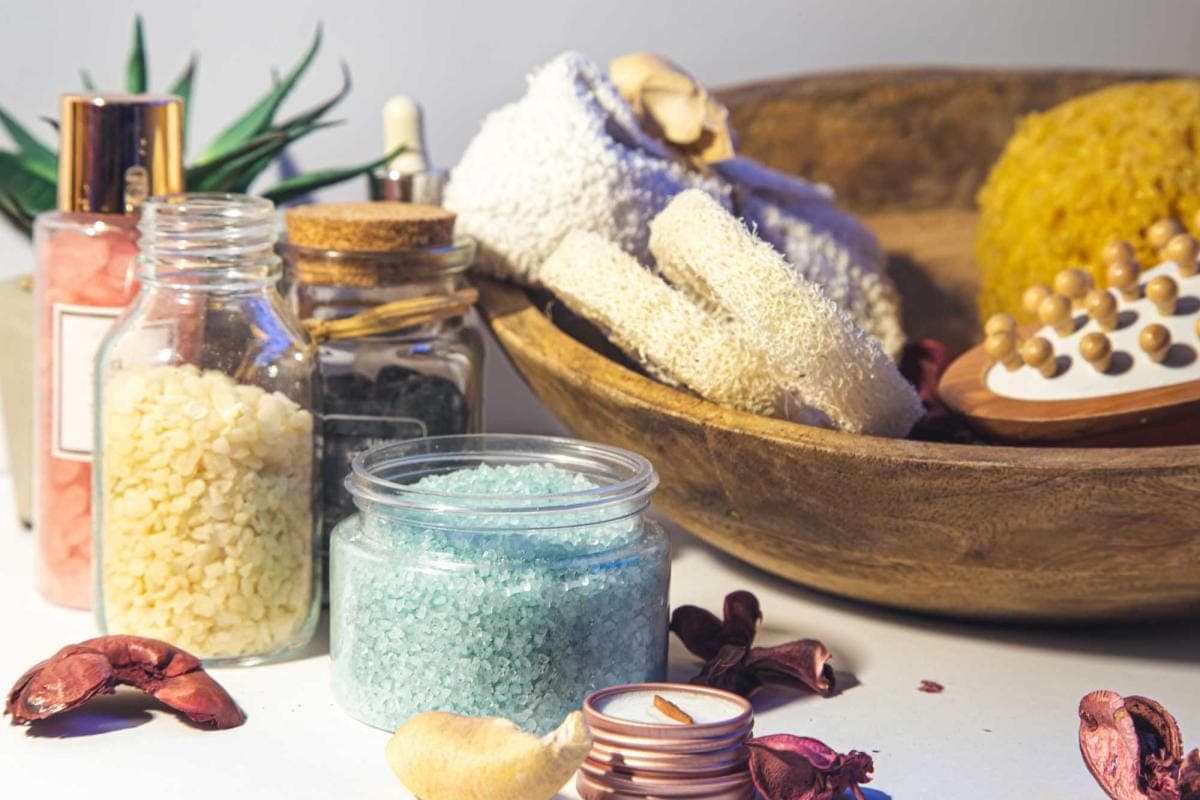There’s a reason Epsom salt has been a staple in households for hundreds of years. It’s not trendy or high-tech, but its effects are often immediate and surprisingly profound. Whether you’re seeking relief from sore muscles, looking for a new way to manage stress, or trying to improve your skin, Epsom salt baths offer a simple solution hiding in plain sight. And the best part? You probably already have it sitting under your bathroom sink.
Magnesium sulfate – the compound that makes up Epsom salt – isn’t just an old wives’ remedy. It’s backed by science, supported by generations of use, and championed by everyone from elite athletes to herbalists. So, what exactly does soaking in this salt do for you?
Let’s unpack the benefits, one long soak at a time.
Muscle Relief That Goes Deep
After a tough workout, it’s tempting to collapse on the couch and do absolutely nothing. But if you truly want to speed up recovery and reduce that next-day soreness, an Epsom salt bath is your best friend. Magnesium, the key element in Epsom salt, plays a critical role in muscle function. When absorbed through the skin, it helps regulate muscle contractions, reduce inflammation, and flush out lactic acid buildup.
Studies have suggested that transdermal magnesium absorption is possible, although more research is still ongoing. Anecdotally, millions of people swear by Epsom salt for this exact reason. After 20 minutes in a warm bath with two cups of salt, tightness in your calves or that stubborn knot in your shoulder often starts to ease up.
It’s also incredibly beneficial for people dealing with chronic muscle tension or conditions like fibromyalgia. The National Fibromyalgia Association notes that warm baths – particularly with Epsom salt – can ease pain and increase circulation, which is often compromised in people with these conditions.

Magnesium’s Quiet Power on Your Mood
One of the more underrated effects of an Epsom salt bath is how it impacts your mental state. Magnesium deficiency has been linked to symptoms of anxiety, irritability, and even mild depression. While dietary magnesium plays a key role in maintaining mental balance, there’s growing interest in how topical exposure might help, especially when combined with the calming ritual of a warm bath.
The magnesium in Epsom salt helps regulate neurotransmitters, which send signals throughout your brain and body. It also plays a role in producing serotonin, a chemical that promotes feelings of well-being and happiness.
The calming effect isn’t just chemical. There’s also something ritualistic and grounding about taking time to unplug, dim the lights, and give yourself 30 minutes of undisturbed calm. For many, it’s the only time of day they’re not multitasking or staring at a screen. That alone is therapeutic.
Improved Sleep Quality
If you struggle to fall asleep or stay asleep, you’re not alone. According to the CDC, nearly 1 in 3 adults in the U.S. don’t get enough sleep on a regular basis. The reasons vary – from stress and screen time to chronic pain – but magnesium might play a bigger role than most people realize.
Low magnesium levels are associated with poor sleep quality and insomnia. When you soak in Epsom salt, the magnesium may help your body produce melatonin, the hormone that regulates sleep cycles. Plus, the simple act of soaking in a warm bath raises your body temperature. Once you step out, the rapid cooling signals your body it’s time to sleep, mimicking the natural decline in temperature that happens before bedtime.
If you’ve ever felt drowsy after a bath and thought, “I could go straight to bed right now,” you’re not imagining it. Your body is getting the memo loud and clear.
Skin Health and Softness
Let’s talk skin. Epsom salt isn’t just about what’s happening under the surface. It’s also a gentle exfoliant that helps slough off dead skin cells and smooth out rough patches. If you struggle with dry elbows, callused feet, or keratosis pilaris (those little bumps on the backs of your arms), regular Epsom salt baths can make a noticeable difference.
It may also be helpful for people with skin conditions like eczema or psoriasis. While it’s not a cure, soaking in Epsom salt can reduce itching and scaling by softening the skin and lowering inflammation. Just make sure to moisturize afterward – salt can be drying if left on the skin too long without replenishing hydration.
There’s also a detoxifying effect to consider. While the concept of “detox” is often overused in wellness marketing, sweating and increasing circulation through hot baths does help the body eliminate toxins through the skin, its largest organ.
Stress Reduction That Feels Intentional
We talk a lot about stress, but we rarely take actionable steps to reduce it – until it reaches breaking point. The beauty of Epsom salt baths is that they’re a built-in pause button. You have to slow down. You have to stop moving. And in today’s hyper-stimulated world, that’s a radical act of self-care.
Beyond the physical benefits, there’s a psychological one: creating space. Whether you use that time to meditate, listen to music, or just breathe, the mental reset that comes from carving out 30 quiet minutes is invaluable.
Research shows that intentional relaxation can reduce cortisol levels (your primary stress hormone), lower blood pressure, and improve overall mood. Pair that with magnesium absorption and muscle relief, and you’ve got a recipe for real change in your daily well-being.
Supporting Detox Pathways
Epsom salt baths have been a staple in natural detox protocols for decades. While your liver and kidneys do the heavy lifting when it comes to eliminating waste, helping your body reduce the external burden – through sweat, skin sloughing, and increased circulation – can make things easier.
Some holistic practitioners recommend Epsom salt baths during cleanses, illness recovery, or even after travel, when your system has been pushed a little harder than usual. By soaking in warm water and sweating gently, your lymphatic system gets a subtle nudge toward better drainage and function.
There’s also evidence that magnesium sulfate supports sulfate levels in the body, which are essential for detoxifying certain environmental chemicals and drugs.

Can It Help with Constipation?
This one surprises people. Epsom salt isn’t just for baths – it can also be taken internally (only the food-grade kind!) as a laxative. But even when used externally in a bath, some people notice improved digestive function afterward.
That’s because relaxing the body and stimulating the parasympathetic nervous system – the “rest and digest” part of your brain – can support better bowel movements. Combine that with increased hydration and a good night’s sleep, and it’s no wonder things get moving the next day.
However, if you’re dealing with ongoing digestive issues, it’s best to consult a doctor before relying on Epsom salt baths alone.
Supporting Healthy Feet and Joints
Your feet take a beating, especially if you’re on them all day. A 15-minute foot soak in Epsom salt can reduce swelling, eliminate odor, and soften tough skin. The antimicrobial properties may also help with athlete’s foot or minor fungal infections.
Joints also benefit from the anti-inflammatory effect of magnesium sulfate. Whether it’s stiffness from arthritis or general wear and tear, warm Epsom salt baths can improve flexibility and reduce discomfort. Think of it as a low-tech, high-reward therapy.
How Often Should You Take Epsom Salt Baths?
This depends on your goals. If you’re using them for muscle recovery after workouts, two to three times a week might be perfect. For stress or sleep support, aim for nightly or every other night, especially during high-pressure times.
Each bath should contain about two cups of Epsom salt in a standard-size tub filled with warm – not boiling – water. Soak for 15 to 30 minutes. Add essential oils like lavender or eucalyptus for extra aromatherapy benefits.
And always hydrate afterward. You’ll lose fluids through sweat and increased circulation, so drink a glass of water to help your body adjust.
Are There Any Risks?
For most people, Epsom salt baths are incredibly safe. However, if you have kidney disease, heart issues, or very low blood pressure, check with your doctor first. Magnesium is processed through the kidneys, so anyone with reduced kidney function needs to be cautious.
Pregnant women can generally use Epsom salt baths, but again, it’s wise to speak to a healthcare provider first – especially if there are any complications or concerns.
Avoid using Epsom salt in very hot water, which can raise your body temperature too quickly and lead to lightheadedness or fatigue.
FAQs
Can Epsom salt baths help with acne?
They can help reduce body acne due to their anti-inflammatory and exfoliating properties, but they’re not a substitute for a targeted skincare routine. Use non-comedogenic moisturizers afterward to keep skin balanced.
Do Epsom salt baths actually detox the body?
They support natural detox pathways, primarily by improving circulation, sweat production, and lymph flow. However, your liver and kidneys still do most of the detoxification.
What kind of Epsom salt should I use?
Look for pure magnesium sulfate without added fragrances or dyes. The brand doesn’t matter as much as the ingredient list. USP-grade (United States Pharmacopeia) is a good quality marker.
Can children take Epsom salt baths?
Yes, in smaller doses. A half-cup in a kid-sized tub is usually sufficient. It’s especially helpful for kids with growing pains, hyperactivity, or trouble sleeping.
How do I store Epsom salt?
Keep it in a sealed container in a cool, dry place. Moisture can cause clumping and reduce its effectiveness over time.
Why is magnesium important?
It supports over 300 enzymatic processes in the body, including nerve function, blood pressure regulation, and energy production. Yet many people are slightly deficient without knowing it.





